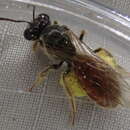zh-TW
在導航的名稱


This species is part of the subgenus Sphecodogastra, treated as a genus in the review of McGinley (2003). Forages for pollen from the Onagraceae (evening primrose family) at dusk and nocturnally (McGinley 2003). Females plug the nest entrance when they leave to forage. This, combined with the restricted foraging period, may reduce brood parasitism (McGinley 2003). Like other bees of the Sphecodogastra group of Lasioglossum, these bees are generally solitary, but with some aspects of social behavior. Females return to their natal nest to overwinter, often with other females. However only one overwintered female typically uses the nest for brood rearing and the others leave to establish their own nests (McGinley 2003). Species distribution: Lasioglossum noctivaga is known from western Texas and Oklahoma, northern New Mexico and Arizona, and eastern Utah, USA (McGinley 2003).Females fly from May to October, but primarily in July and August. Males fly July to October, but primarily in July (McGinley 2003).